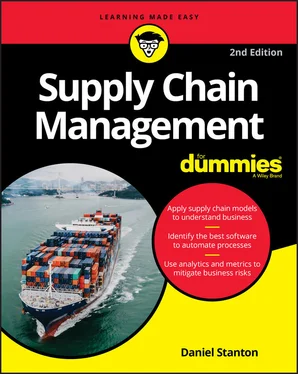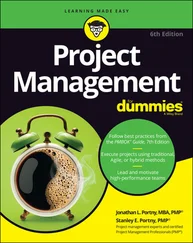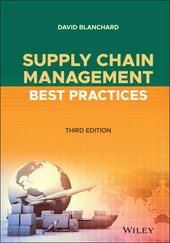1 ...7 8 9 11 12 13 ...19  A few universities require their supply chain management students to take classes in system dynamics, which includes a set of tools for predicting how supply chains behave over time. The concept of system dynamics was developed in the 1950s by MIT professor Jay Forrester.
A few universities require their supply chain management students to take classes in system dynamics, which includes a set of tools for predicting how supply chains behave over time. The concept of system dynamics was developed in the 1950s by MIT professor Jay Forrester.
 System dynamics modeling usually requires special software. You’ll find reviews of several options at
System dynamics modeling usually requires special software. You’ll find reviews of several options at www.systemdynamics.org/core-software , but if you’re looking for a simple tool that lets you build your own system dynamics model for free, check out Insight Maker at https://insightmaker.com .
Measuring Supply Chain Processes
Supply chains can be viewed in terms of flows, functions, communities, or systems. But no matter how you look at it, effective supply chain management requires being able to measure what’s happening. Virtually every process in a supply chain can be measured with quantitative or qualitative metrics.
Quantitative metrics are objective, numerical indicators. Qualitative metrics describe intangible characteristics. Quantitative metrics might include things like current inventory levels or the amount of money spent on transportation. Qualitative metrics could describe the level of employee engagement or customer satisfaction. Table 2-1lists some common types of qualitative and quantitative metrics.
TABLE 2-1Quantitative versus Qualitative Metrics
| Quantitative |
Qualitative |
| Times |
Degree of satisfaction |
| Rates |
Likelihood of doing something |
| Values |
Perceptions |
| Amounts |
Desire or need |
| Frequencies |
Level of agreement |
Collecting measurements costs money and takes time, so it’s important to decide which metrics you really need. The key is to identify the steps in each supply chain process that will be most useful for understanding how things are working and what decisions you need to make. The metrics that give you this insight are called key performance indicators (KPIs). The KPIs in one business or facility can be very different from the KPIs in another, depending on which processes are most important to each organization. (For more information about metrics, see Chapter 16.)
A good way to look for improvement opportunities in any process is to compare your own performance with that of someone else. You can compare the KPIs from one facility with the KPIs at another or from one company to another, for example. Comparing KPIs in this manner is an example of benchmarking. Companies can benchmark their supply chain KPIs by using the Supply Chain Operations Reference (SCOR) Model, which is covered in Chapter 5. Benchmarking has become so popular that many companies have built their entire businesses on collecting, evaluating, and reporting on supply chain KPIs.
 Companies (even competitors!) share benchmarking data all the time. But sharing business information can lead to problems if it violates laws such as the Clayton Antitrust Act. Before you start benchmarking with other companies, it’s a good idea to talk to a corporate attorney.
Companies (even competitors!) share benchmarking data all the time. But sharing business information can lead to problems if it violates laws such as the Clayton Antitrust Act. Before you start benchmarking with other companies, it’s a good idea to talk to a corporate attorney.
There are lots of ways to look at a supply chain. To manage a supply chain well, you need to understand each of these perspectives and use them to select the KPIs that give you visibility into how your supply chain is performing. Benchmarking those KPIs against other facilities and other companies can reveal areas in which you’re doing well and opportunities for improvement.
Chapter 3
Digging into Your Supply Chain
IN THIS CHAPTER
 Establishing your supply chain priorities
Establishing your supply chain priorities
 Balancing cost and value
Balancing cost and value
 Compromising to improve results
Compromising to improve results
Before you can manage something, you have to understand how it works and what you want it to do. A supply chain is no exception. Many kinds of supply chains exist, and each of them needs to deliver a different kind of product or service to meet customers’ needs. This chapter covers the factors that define how a supply chain needs to perform and how each factor affects costs. Then the chapter discusses how trade-offs are managed in every supply chain.
Prioritizing Supply Chain Goals
A friend of mine has a sign on her desk that reads “Good, Fast, Cheap … Pick Any Two.” The message is relevant for supply chain management because you often have to figure out what’s most important to you and be willing to compromise on the rest.
Step 1: Understand what customers value
To make good decisions about what to prioritize in a supply chain, start with your customers. Because the purpose of a supply chain is to deliver value to a customer, the first step in engineering and managing a supply chain is understanding exactly what your customers value. They may value having a wide variety of products to choose among, for example, or they might prefer to have a smaller number of options at a lower price. Alternatively, your customers may value having products available immediately for pickup or to have products delivered to their homes at a time that they choose.
Your customers may actually want “all of the above,” but each choice creates different requirements for a supply chain, and the choices may be contradictory. It often helps to choose a key customer and focus on their specific preferences.
Some great techniques are available to help you identify what customers value most. One of the most popular of these techniques is officially called Quality Functional Deployment (QFD), but many people call it the House of Quality (HOQ). Figure 3-1 shows an example HOQ, which looks like a bunch of boxes with a roof on top. To build an HOQ, first you interview customers to determine which characteristics or features they value most. Then you match those features with your design to ensure that you’re focusing on delivering products and services that genuinely meet your customers’ needs.

FIGURE 3-1:Example HOQ.
 For more information on how to build an HOQ , visit
For more information on how to build an HOQ , visit https://hbr.org/1988/05/the-house-of-quality .
Another common technique for determining customer preferences is called A/B testing. To perform an A/B test, you give your customer a choice between two options: A and B. Online shopping sites frequently use A/B testing to see which products or ads are most attractive to customers, but A/B testing can also be used in face-to-face experiments.
Читать дальше

 A few universities require their supply chain management students to take classes in system dynamics, which includes a set of tools for predicting how supply chains behave over time. The concept of system dynamics was developed in the 1950s by MIT professor Jay Forrester.
A few universities require their supply chain management students to take classes in system dynamics, which includes a set of tools for predicting how supply chains behave over time. The concept of system dynamics was developed in the 1950s by MIT professor Jay Forrester. System dynamics modeling usually requires special software. You’ll find reviews of several options at
System dynamics modeling usually requires special software. You’ll find reviews of several options at  Companies (even competitors!) share benchmarking data all the time. But sharing business information can lead to problems if it violates laws such as the Clayton Antitrust Act. Before you start benchmarking with other companies, it’s a good idea to talk to a corporate attorney.
Companies (even competitors!) share benchmarking data all the time. But sharing business information can lead to problems if it violates laws such as the Clayton Antitrust Act. Before you start benchmarking with other companies, it’s a good idea to talk to a corporate attorney. Establishing your supply chain priorities
Establishing your supply chain priorities











